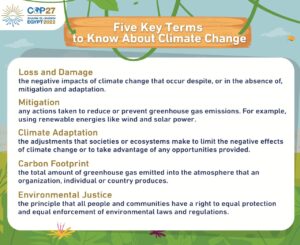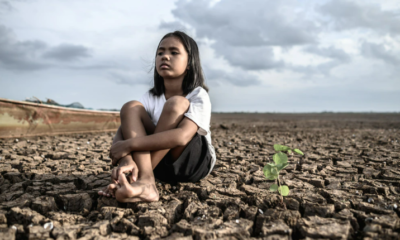Cop27
Five Key Climate Change Terms to Know

By Omnia Shahin
The 27th Conference of the Parties (COP27) of the United Nations Framework Convention on Climate Change (UNFCCC) is currently held in Sharm el-Sheikh, Egypt’s first sustainable green city, during the period from 6 to 18 November 2022. According to Egypt’s Presidential Vision, the COP27 is about moving from ‘negotiations and planning for implementation’.
The thematic days this year focus on discussing the topics of: Finance, Science, Youth and Future Generations, Decarbonization, Adaptation and Agriculture, Gender, Water, Ace and Civil Society, Energy, Biodiversity and Solutions.
In the coming lines, we shed light on five key climate change terms to grasp what is going on in the world with climate change.
Loss and Damage
The UNFCCC does not have an agreed-upon definition for loss and damage. However, in the context of climate change, loss and damage ‘can generally be understood as the negative impacts of climate change that occur despite, or in the absence of, mitigation and adaptation’. The term is often categorized as either economic or non-economic.
Mitigation
Mitigation refers to ‘any actions taken to reduce or prevent greenhouse gas emissions’. This includes planting trees in order to absorb more carbon dioxide, legislation promoting conservation, investments in clean technology, developing and deploying new technologies, or using renewable energies like wind and solar power. Therefore, efforts to reduce emissions and enhance sinks are referred to as mitigation.
Climate Adaptation
Climate change adaptation refers to the adjustments made in ecological, social or economic systems. This can be achieved either by limiting the negative effects of climate change or taking advantage of opportunities provided by a changing climate. Adaptation ‘can range from farmers planting more drought-resistant crops to coastal communities evaluating how best to protect themselves from sea level’. To respond to the already-happening impacts of climate change, countries and communities need to develop adaptation solution and prepare for future impacts.
Carbon Footprint
A carbon footprint is the total amount of greenhouse gas emitted into the atmosphere that an organization, individual or country produces. Among these emissions are carbon dioxide, methane, nitrous oxide and fluorinated gases.
Environmental Justice
To put it simply, environmental justice is broadly understood as ‘the principle that all people and communities have a right to equal protection and equal enforcement of environmental laws and regulations’. Regardless of one’s race, color, national origin or income; environmental justice includes all people in the development and enforcement of environmental policies.













